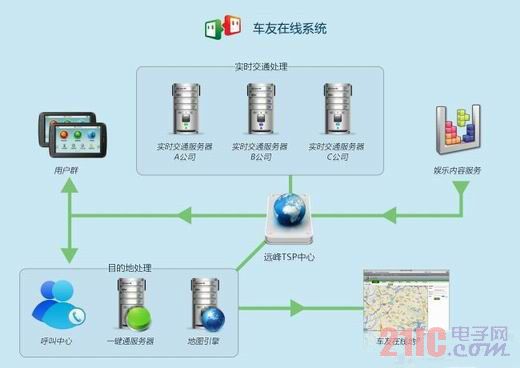Car infotainment shows multi-functional needs
The rapid development of electronic technology has made traditional in-vehicle products (such as car DVDs, car amplifier systems, etc.) face the trend of being eliminated, while in-vehicle infotainment systems based on satellite navigation and equipped with various control networks have shown a strong competitive advantage. At present, the in-vehicle infotainment system has been developed quite mature in technology. How to achieve a better application experience for consumers at a low price has become the most concerned issue of various manufacturers. Mr. Fang Weidong, General Manager of Automotive Electronics Division of Malata Group believes that: "The future technological development of in-vehicle infotainment products will mainly focus on functions, such as the introduction of the Internet and car networking. The in-vehicle infotainment function will be completed by the network. In-vehicle infotainment system The use of the Internet and automotive intranets will become more and more popular." This article refers to the address: http:// "With the popularization and application of GPS positioning technology, its development direction will show a diversified trend. Many independent GPS technologies that are recognized by the industry are gradually disappearing. GPS positioning technology is widely used in various electronic products. Becoming a public intersection of these electronic products.†Mr. Cui Wei, Marketing Director of Yuanfeng Technology Co., Ltd. pointed out. The pre-installation market of China's in-vehicle infotainment system is expected to break out from the end of next year to the beginning of next year. At that time, the amount of car navigation will reach 1/4~1/2 of the market size. At the same time, The pre-installation market for in-vehicle infotainment will be extended to some joint ventures by some local companies (such as BYD, Changan, Haima, Chery and other first-line brands), mainly focusing on passenger cars with a grade of about 100,000 yuan ( Secondary city car). Figure: Yuanfeng Cheyou online system. The difficulty in the front-loading market of in-vehicle infotainment systems is mainly in terms of cost performance. At this stage, the technology of the car infotainment system is no longer a problem, all the required functions can be satisfied, and how to achieve the performance price balance of the car infotainment system is still the most headache for developers. In the aftermarket of in-vehicle infotainment systems, some of the set of in-vehicle infotainment products are priced at only 1,000 yuan, and whether the performance can meet the requirements is worthy of questioning. For the application of car GPS products, Android platform, multimedia and 3G communication technology will be the three major development directions of the industry. Therefore, the development of two-way communication of in-vehicle infotainment products (relative to the one-way reception of GPS) and value-added service applications (such as YFMAP provided by Yuanfeng, online service of riders) are the core of in-vehicle infotainment products. . Mr. Yan Haifeng, CTO of Yuanfeng Technology, said that the previous GNSS systems are basically based on the positioning technology of a single constellation system, such as GPS in the United States. However, such a system faces the following problems: the signal of the GPS system is affected by the US national policy, so that positioning based on the signal of the system has certain unreliability; after the development of the past few years, the positioning technology based on the GPS system is quite mature. There is limited room for further improvement in the future. The great changes in the relevant technical fields in the past few years include: the Glonass system in Russia is maturing, and the Beidou system using China's independent knowledge technology will be successfully applied to all walks of life in the near future. Based on GPS+Glonass dual-system positioning and navigation products developed by Yuanfeng, the accumulated technology can also be applied to GPS+ Beidou navigation products, which will prepare for the industrialization of China Beidou technology in the future. In recent years, due to the rapid development of MEMS technology and the popularization of sensors such as Gyro and G-Seneor based on MEMS technology on iPhones and other products, blind area navigation (DR) eliminates the need for traditionally expensive and bulky sensors. The use of MEMS-based sensors enables inexpensive implementation of DR in car navigation and even on portable navigation systems. Continuous positioning is possible even in the basement or in the tunnel. Yan Haifeng emphasized that the most important technical challenge is how to increase the support of Glonass or Beidou in the original GPS-only system, especially compatible with Glonass or Beidou under the premise of existing antenna and RF architecture. This aspect is also worthwhile to break through some of the inherent thinking and make the product as good as possible. At present, the GPS navigation network mainly adopts a static programming algorithm, which determines that the car navigation function cannot perform more accurate analysis on the actual road conditions. How to improve the route planning function of the car GPS depends mainly on the collection and processing of dynamic data by the state. The lag of processing time will result in the in-vehicle GPS not being able to obtain the data information required for navigation in time. The growing maturity of the Glonass system and the Beidou system will compete with GPS in this industry. Through the formation of this kind of competition mechanism, after adopting multi-network interaction technology in the near future, the accuracy of car navigation products will be expected to increase from the current ten meters to one meter. At present, the GPS system can not give the information of the static direction angle, and it will be expected to be solved by then. Complex interactive operations exist in multi-network interaction technology. Yuanfeng's two-way communication technology provides interactive full-motion, real-time update and real-time error correction navigation functions. It can speed up satellite reception speed and capability by using multiple means of integrated, multi-network, electronic compass and AGPS technology. Decorative Wall Lights,Decorative Lights,Wall Art Decor,Light Decoration Guangzhou Huanyu Clocking Technologies Co., Ltd. , https://www.findclock.com